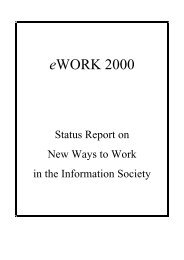Proceedings of 8th European Assembly on telework (Telework2001)
Proceedings of 8th European Assembly on telework (Telework2001)
Proceedings of 8th European Assembly on telework (Telework2001)
You also want an ePaper? Increase the reach of your titles
YUMPU automatically turns print PDFs into web optimized ePapers that Google loves.
47The AWAI Index is distinguished from existing labour market flexibility indices (such as theOECD’s Labour Market Flexibility Index) by the inclusi<strong>on</strong> <str<strong>on</strong>g>of</str<strong>on</strong>g> indicators that measure workercentredflexibility (e.g. <strong>telework</strong>ing, discreti<strong>on</strong> over working times and weekly working hours,company-provided training). This approach ensures that AWAI Index results are capable <str<strong>on</strong>g>of</str<strong>on</strong>g>presenting a picture <str<strong>on</strong>g>of</str<strong>on</strong>g> the EU labour market situati<strong>on</strong> that is in line with the <str<strong>on</strong>g>European</str<strong>on</strong>g> EmploymentPolicy’s emphasis <strong>on</strong> socially sustainable new ways <str<strong>on</strong>g>of</str<strong>on</strong>g> working in the Informati<strong>on</strong> Society.The paper ends with some c<strong>on</strong>clusi<strong>on</strong>s and the specificati<strong>on</strong> <str<strong>on</strong>g>of</str<strong>on</strong>g> further research requirements.2. Telework as the Precursor <str<strong>on</strong>g>of</str<strong>on</strong>g> e-Work: the Current Situati<strong>on</strong> in EuropeThe history <str<strong>on</strong>g>of</str<strong>on</strong>g> <strong>telework</strong> dates back to the early 1970s when Jack Schiff in 1972 in the ‘Washingt<strong>on</strong>Post’ coined this term. It was Jack Nilles, described as the ‘father <str<strong>on</strong>g>of</str<strong>on</strong>g> telecommuting’, whostarted intensive research <strong>on</strong> this subject in his ‘Telecommunicati<strong>on</strong>s – Transportati<strong>on</strong> Trade-<str<strong>on</strong>g>of</str<strong>on</strong>g>f’publicati<strong>on</strong> in 1976 [17]. In the early 1980s <strong>telework</strong> started to become a research topic in Europewith the work <str<strong>on</strong>g>of</str<strong>on</strong>g> Huws [13] and empirica [14]. In those days it was true that is was as hard t<str<strong>on</strong>g>of</str<strong>on</strong>g>ind <strong>telework</strong>ers as it is to ‘find a pin in a haystack’ and that there were probably more researchersdealing with the subject than actual <strong>telework</strong>ers [5]. Even in 1994 <strong>on</strong>ly between 0.4% <str<strong>on</strong>g>of</str<strong>on</strong>g> theemployees in Germany and 1.7% in the UK worked as <strong>telework</strong>ers from home [15]. Today thishas changed significantly with already 6% <str<strong>on</strong>g>of</str<strong>on</strong>g> the <str<strong>on</strong>g>European</str<strong>on</strong>g> labour force practising some kind <str<strong>on</strong>g>of</str<strong>on</strong>g><strong>telework</strong> in 1999 [2]. This sums up to 9 milli<strong>on</strong>; we estimate that by now (2001) the figure is up to12 milli<strong>on</strong> <str<strong>on</strong>g>European</str<strong>on</strong>g> <strong>telework</strong>ers. Most <str<strong>on</strong>g>of</str<strong>on</strong>g> these <strong>telework</strong>ers are regular <strong>telework</strong>ers as opposed tosupplementary <strong>telework</strong>ers (see Figure 1).Figure 1:Regular and supplementary <strong>telework</strong>ers as % <str<strong>on</strong>g>of</str<strong>on</strong>g> labour forceSource: empirica ECaTT 1999








